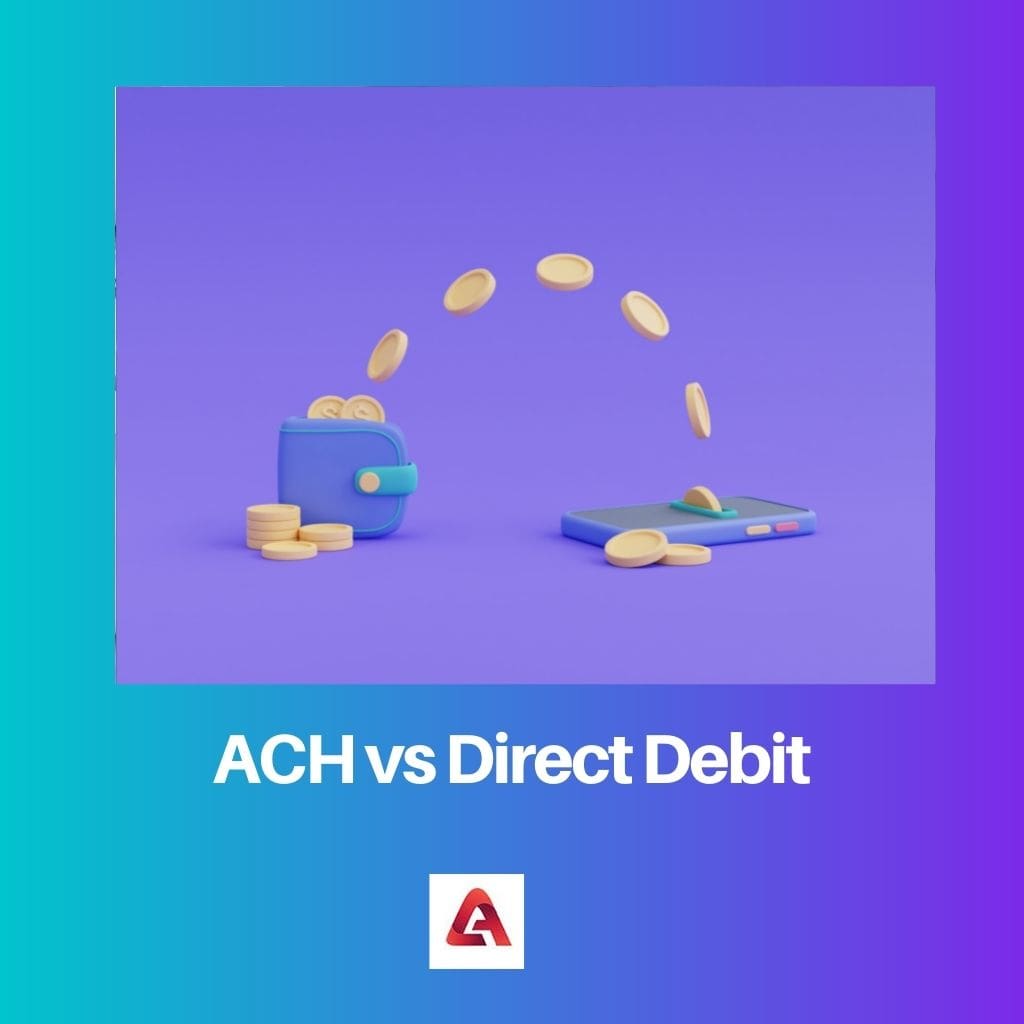ACH (Automated Clearing House) is a system facilitating electronic funds transfers within the US, enabling individuals and businesses to send and receive payments electronically, often used for recurring payments like utility bills. Direct Debit, prevalent in Europe, is a similar system allowing authorized parties to withdraw funds directly from a customer’s bank account, commonly used for subscription services or loan repayments.
Key Takeaways
- An automated Clearing House (ACH) is a network for processing electronic financial transactions, including direct deposits and bill payments; direct debit is a specific type of transaction that allows a business or organization to collect funds from a customer’s bank account.
- ACH is a broader system encompassing various electronic transactions, while direct debit is a single payment method within the ACH system.
- ACH and direct debit facilitate electronic fund transfers, but ACH includes a wider range of transaction types, whereas direct debit specifically focuses on collecting payments.
ACH vs Direct Debit
ACH (Automated Clearing House) payments are used for one-time or recurring transactions between individuals or organizations. Direct Debit is used for recurring transactions where the payer authorizes the payee to withdraw funds from their bank account at regular intervals, such as monthly bills.

The bank-to-bank fund’s transfer electronically happens with the help of ACH payment. The transfer is made through the network of ACH instead of other payment networks.
A provider of electronic funds transfer services in the United States, handling automated payments such as direct debit and direct credit. Direct debit is one of the main categories in ACH payments.
Direct debit is a payment method in which the account holder is granted permission to take payments from a bank account to pay a fixed amount (Mortgage loans or rent) or variable amount (utility bills and others) directly to the bank or supplier.
Comparison Table
| Feature | ACH | Direct Debit |
|---|---|---|
| Definition | A network that facilitates electronic funds transfers between banks in the United States | A type of ACH transaction where the receiver initiates the transfer, pulling funds from the payer’s account |
| Initiation | Can be initiated by either the payer (ACH credit) or the receiver (ACH debit, including direct debit) | Always initiated by the receiver |
| Authorization | Requires one-time authorization from the payer for each transaction (except for recurring payments) | Requires a standing agreement from the payer, authorizing the receiver to withdraw funds on a recurring basis |
| Examples | Direct deposit, payroll, person-to-person transfers, bill payments initiated by the payer | Utility bills, gym memberships, subscription services, recurring donations |
| Control | Payer has more control over individual transactions | Receiver has control over the timing and amount of withdrawals, but payer can cancel the authorization at any time |
| Dispute Resolution | Requires the payer to initiate a dispute with their bank | May involve both the payer and the receiver depending on the specific circumstances |
| Cost | Typically free for standard transfers, but may have fees for expedited or international transactions | May have fees associated with the service, charged by either the receiver or the payer’s bank |
What is Automated Clearing House?
1. Operational Mechanism:
The ACH system operates through batch processing, where transactions are grouped together and processed in batches at predetermined intervals, typically daily. These transactions include both credits (money sent) and debits (money received). Each batch undergoes a series of steps, including initiation, authorization, clearing, and settlement, ensuring the secure and efficient transfer of funds between accounts.
2. Participants and Roles:
Participants in the ACH network include financial institutions, businesses, and individuals. Financial institutions, such as banks and credit unions, act as Originating Depository Financial Institutions (ODFIs) or Receiving Depository Financial Institutions (RDFIs), depending on whether they initiate or receive ACH transactions. Businesses and individuals can utilize the ACH network through their financial institutions to initiate transactions, either as an originator or a receiver of funds.
3. Types of Transactions:
The ACH network supports various types of transactions, including:
- Direct Deposit: Employers use the ACH system to deposit employees’ salaries directly into their bank accounts, offering convenience and efficiency in payroll processing.
- Preauthorized Payments: Businesses and consumers can authorize recurring payments, such as utility bills, mortgage payments, and insurance premiums, to be automatically debited from their bank accounts on specified dates.
- Person-to-Person Payments: Individuals can transfer funds to friends, family, or acquaintances electronically, often through online banking platforms or mobile apps, leveraging the ACH network for secure and convenient peer-to-peer transactions.
4. Regulatory Framework:
The ACH system is governed by regulations set forth by the National Automated Clearing House Association (NACHA) and overseen by the Federal Reserve and the Electronic Payments Network (EPN). These regulations establish rules and standards for participants in the ACH network, ensuring the safety, security, and efficiency of electronic payments. Compliance with regulatory requirements is essential for financial institutions and businesses involved in ACH transactions to maintain trust and integrity within the system.

What is Direct Debit?
1. Operational Mechanism:
Direct Debit operates through an agreement between a customer (known as the payer) and an organization (known as the payee). The payer authorizes the payee to collect payments directly from their bank account on agreed-upon dates. These payments can be one-time or recurring, such as monthly subscriptions, utility bills, loan repayments, or membership fees. The payee initiates the transaction, and the payer’s bank, known as the payer’s financial institution, facilitates the transfer of funds to the payee’s bank account.
2. Benefits and Advantages:
- Convenience: Direct Debit offers convenience for both payers and payees. Payers can automate bill payments, eliminating the need to manually initiate payments each month. Payees benefit from predictable cash flows and reduced administrative costs associated with processing payments.
- Reduced Late Payments: Direct Debit helps reduce the incidence of late payments since payments are automatically withdrawn from the payer’s account on specified dates, ensuring bills are paid on time.
- Cost-Effective: Direct Debit is often more cost-effective than traditional payment methods, such as checks or manual bank transfers, as it reduces administrative overhead and the risk of payment errors.
3. Regulatory Framework:
Direct Debit systems are regulated to ensure the security and reliability of transactions. Regulatory bodies, such as the European Payments Council (EPC) in Europe, establish rules and standards governing Direct Debit transactions. These regulations outline the rights and responsibilities of both payers and payees, ensuring transparency, security, and dispute resolution mechanisms. Compliance with regulatory requirements is essential for organizations offering Direct Debit services to maintain trust and integrity within the payment ecosystem.
4. Consumer Protections:
Direct Debit systems often include consumer protections to safeguard the interests of payers. These protections may include the ability for payers to cancel or dispute unauthorized transactions, set limits on the amounts that can be withdrawn, and receive advance notice of upcoming payments. Regulatory authorities enforce these protections to ensure fair treatment and transparency in Direct Debit transactions, fostering confidence among consumers and businesses alike.

Main Differences Between ACH and Direct Debit
- Geographic Usage:
- ACH is predominantly used in the United States, facilitating electronic funds transfers within the country’s banking system.
- Direct Debit is more prevalent in Europe and other regions outside the US, serving as a common method for recurring payments and subscriptions.
- Regulatory Framework:
- ACH transactions in the US are governed by regulations established by organizations like NACHA, the Federal Reserve, and the EPN.
- Direct Debit transactions are regulated by different authorities depending on the country or region, such as the European Payments Council (EPC) in Europe, ensuring compliance with local laws and standards.
- Authorization Process:
- ACH transactions often require authorization from both the sender and the receiver, with various security measures in place to ensure the legitimacy of transactions.
- Direct Debit typically involves a one-time authorization from the payer (account holder) to the payee (merchant or service provider), allowing the payee to initiate future transactions without further approval for recurring payments.
- Transaction Timing:
- ACH transactions in the US typically take 1-2 business days to process, with funds becoming available in the recipient’s account within this timeframe.
- Direct Debit transactions can vary in processing time depending on the country and banking system, but they often offer quicker settlement compared to traditional paper-based methods, enabling timely payments and collections.
- Use Cases:
- ACH transactions are commonly used for various purposes, including payroll direct deposits, bill payments, business-to-business transfers, and person-to-person payments.
- Direct Debit is primarily utilized for recurring payments, such as subscription services, membership fees, loan repayments, and utility bills, providing a convenient and automated way for businesses to collect payments from customers on a regular basis.
- http://www.medien.ifi.lmu.de/lehre/ws0910/mmn/mmn7.pdf
- https://ieeexplore.ieee.org/abstract/document/570823/
- https://fraser.stlouisfed.org/files/docs/publications/frbclevreview/pages/1995-1999/68731_1995-1999.pdf

This article provides an in-depth explanation of Automated Clearing House (ACH) and Direct Debit, and the differences between the two. It is informative and very useful for anyone wanting to understand these financial management processes.
I completely agree! I’ve always struggled to distinguish between the two, and this article has really helped clarify things for me!
These payment methods seem to be very beneficial for business entities and individuals. The article outlines the differences between Automated Clearing House and Direct Debit in an insightful manner.
The details provided about Automated Clearing House and Direct Debit are well-researched and comprehensive. This article is a valuable resource for understanding these financial processes.
Yes, the table was very informative and easy to understand.
Absolutely, I found the comparison table particularly useful in getting a clear picture of their distinctions.